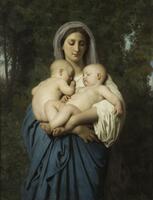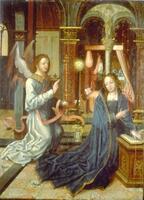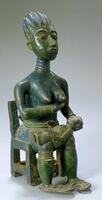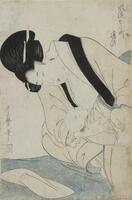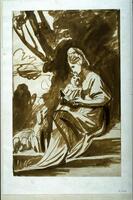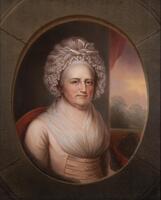Barbara Hepworth - Sphere with colour (Grey and white).
Much of Hepworth’s sculptural work is white, or sometimes black or bronze. She also made some work of hard Nigerian guaranteed wood, which was sent to her by a friend. Her work often has the theme of pregnancy or childbirth, including abstract figures with a rounded, womb-like hole. The idea of “pierced” shapes was taken up by other sculptors at the time, notably Henry Moore. Hepworth had a son by her first marriage, and subsequently triplets when married to the artist Ben Nicholson.
This sculpture, unlike Hepworth’s mainly white sculptures, is carved from striped green marble. The indents, when viewed at a distance (at least 6 ft with one eye closed is best) as you walk around, appear to be floating above the surface, like moons orbiting a planet.
1964, the year before this sculpture is officially dated, was the 4th centenary of Galileo’s birth. He is famous for his use of the new technology of the telescope in observing Jupiter’s moons, Io, Europa, Ganymede, and Callisto. Hepworth had Italian friends, who could easily have written to her with letters bearing the contemporary postage stamps commemorating Galileo. Magazine articles were published at the time about new observations of Jupiter, which would have been easily visible shining brightly in the night sky from her studio in St Ives, overlooking the Atlantic Ocean.
However, Sphere with colour (Grey and White) has only three moon-like indents, whereas Jupiter has four main moons, as discovered by Galileo. Returning to Hepworth’s more common theme of pregnancy and motherhood, the question arises again, why only three indents?
Hepworth had four children; three were triplets. Could this refer to the triplets? Or could it be telling us about her oldest son Peter, an RAF pilot who was killed in a plane crash in Thailand ten years earlier (1953)? Mourning her son, she may have felt like a planet missing its moon.
9 Items in this Learning Collection
Copyright
Growing Forms
1980/1.213A
Title
Growing Forms
Artist(s)
David Smith
Object Creation Date
1939
Medium & Support
cast aluminum on wood base
Dimensions
27 15/16 in x 8 11/16 in x 6 3/10 in (70.96 cm x 22.07 cm x 16.03 cm);27 15/16 in x 8 11/16 in x 6 3/10 in (70.96 cm x 22.07 cm x 16.03 cm);69 3/10 in x 13 in x 13 in (176.05 cm x 33.02 cm x 33.02 cm)
Credit Line
Bequest of Charles E. Palmer in honor of Jean Paul Slusser
Label copy
March 28, 2009
David Smith was virtually untrained as an artist. He made his first welded sculptures in 1933 using skills he had learned on the automobile production line during time off from school, an experience that was formative of his sculptural process. He credited the welded metal sculptures of Pablo Picasso (1881–1973) and Julio González (1876–1942) with giving him the license to use a skill he learned in manufacturing to make art. This is one of the very few metal sculptures that Smith executed during the war years, when metal was extremely scarce. Some have interpreted the teardrop-shaped abstract form as depicting a fetus suspended in the womb; it may also be a “glyph,” Smith’s term for the hieroglyph-like symbols that he used to represent complex psychic states. The totemic wooden base that is integral to the work and the stark opposition between the composite parts’ tactile surfaces are nods to the sculptor Brancusi, for whom Smith professed great admiration.
Subject matter
About organic form in itself, this sculpture includes an abstracted figure who could be either a woman or a fetus in the womb. The elements make the piece a commentary on the organic, fertility, and nurture. The closed form with its internal voids reflects simultaneously on protection and vulnerability.
Physical Description
A roughly teardrop-shaped sculpture of shiny cast aluminum. Within the basic organic shape are several curls and a shape that appears to be a woman or perhaps a fetus. The sculpture sits atop a tall wooden base composed of a stack of fat disc shapes.
Primary Object Classification
Sculpture
Primary Object Type
casting
Additional Object Classification(s)
Sculpture
Collection Area
Modern and Contemporary
Rights
If you are interested in using an image for a publication, please visit http://umma.umich.edu/request-image for more information and to fill out the online Image Rights and Reproductions Request Form.
Keywords
Surrealist
biomorphic abstraction
births
figures (representations)
growth
metal
sculpture (visual works)
